KSR-2: the missile that saved the Tu-16
In the Khrushchev years, the party-state leadership of the Soviet Union, embraced by "missile euphoria", headed for the reduction of traditional types of armed forces. In the second half of the 50s, the assault was liquidated. Aviation, at the beginning of the sixties, thousands of Il-28s, which had not served for ten years, were thrown under the knife. A similar fate could befall the Tu-16. To solve their main task - the delivery of nuclear weapons to targets in Western Europe and the Far East - hundreds of medium-range ballistic missiles R-12, invulnerable to air defense systems, were deployed. The only hope for the continued existence of the Tu-16 was associated with the conversion of bomber and mine-torpedo aircraft into a missile carrier, with the corresponding re-equipment of aircraft.
The development of the K-10C missile made it possible to create a new complex with sufficiently high tactical and technical characteristics for its time, but did not solve the problem of maintaining the effectiveness of the previously formed grouping of Tu-16 aircraft. Under the K-10C, a new missile carrier was needed with the possibility of placing in the nose a fairly large equipment of the EH station, and in the Air Force nearly a thousand Tu-16A bombers and other modifications were already in operation. A more realistic was the massive revision of the bombers in the Tu-16X - the carriers of "Komet".
However, according to the leadership of the Air Force, this complex no longer complied with the requirements for the combat system. In particular, at the beginning of 1957, Deputy Commander of the Air Force SI In his address to the Ministry of Aviation Industry, Rudenko noted the following shortcomings of the Kometa complex: limiting the launch speed at permissible speed pressures when the K-P guidance station was advanced; lack of reliability of target acquisition by homing head (GOS) of the rocket; the impossibility of salvo application due to mutual interference; significant restrictions on the height of the launch of rockets, which was determined mainly by difficulties in launching the TRD RD-500K.
By this time, the industry had already managed to expand the range of engine start heights, but not higher than 7000. Improving the CS was one of the most important tasks of the team of the branch of the Mikoyan design bureau, organized in 1949 at the serial plant in Dubna. By the mid-fifties, in addition to fine-tuning missiles, the branch was also commissioned to develop independently. Its leader, Alexander Yakovlevich Bereznyak, was appointed chief designer of the P-15 - the first cruise missile in the USSR, designed to arm boats.
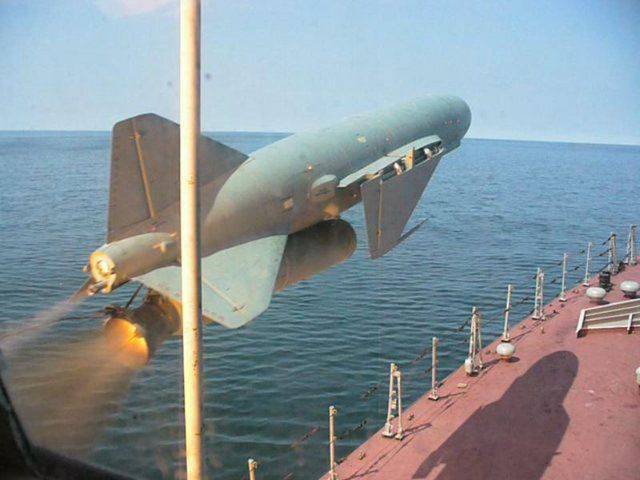
New work again brought together Bereznyak with his co-author of the first domestic missile interceptor BI - Alexei Mikhailovich Isaev, under whose leadership in the OKB-2 NII-88 (head rocket institute of the Ministry of Defense Industry) for a launch missile they developed a special design standard with a load up to 1200 kg. The use of such an engine instead of a TRD at a CS close to the P-15 in terms of weight and dimensions would remove all problems with the launch height.
In principle, there could be another way - to refine the P-15 for interfacing with the aircraft carrier, but in this case the range of the aviation complex could be reduced: the original launch vehicle was calculated to be used at a distance of 25 km. However, in the 1960 year, for the commissioning of the P-15 into service, the range was brought to 35 km, then to 40 km. Later, the zealous Chinese, without further ado, still hung the modified P-15 under the wings of their B-6 bombers, which are licensed Tu-16, but this was in another country and at a different time.
And in the mid-fifties P.V. Dementiev, A.Ya. Bereznyak and A.I. Mikoyan appealed to the country's leadership with a proposal to develop a DAC product, a variant of a rocket engine rocket launcher. The proposal was supported, and the Council of Ministers ordered to carry out development work during the period from 1956 to 1957, to replace the RD-500K with the LRE. At first, it was envisaged to borrow for the new product of the plane of the wings, the tail, and also the K-1M equipment of the original KS rocket, modifying the fuselage under the new propulsion system.
It was supposed to use LRE type С2.722 from П-15 in the standard version, but in the future to ensure a longer operating time taking into account the specificity of the application from the aircraft, the engine was modified with assignment of a new designation С2.711В. The fuel used was a mixture of an equal amount of triethylamine and xylidine, used even in the German rocket technology of the Second World War period under the name "thin", and we have received the designation TG-02. The oxidizer AK-20F based on nitric acid was fairly traditional. The introduction of 20% nitric tetroxide into the oxidizer made it possible to increase the density by 6% and increase the specific impulse by 5%. As an inhibitor, a small amount of orthophosphoric acid was added to the oxidizing agent.
Due to the need to provide increased thrust at the missile acceleration site, and a more economical mode during the flight, the engine, like its prototype on the P-15 rocket, was made dual-mode. The transition from the 1200 kg thrust to the 600 kg level was accomplished by means of a valve located in the component supply system. Fuel consumption decreased, while sustained combustion was ensured with a nearly two-fold decrease in pressure in the combustion chamber.
A more voracious engine demanded more fuel. In addition, a two-fold increase in the launch range was provided in comparison with the CS. As a result, the volume of the fuel tank was 777 l, the oxidizer - 1032 l. In accordance with the aggressive nature of the oxidizer, the tank was made of stainless steel, although it was in those years that the designers of ballistic missiles had already learned how to make acid tanks from lighter aluminum alloys traditional for aviation. As a result of the fact that the stock of fuel has grown almost 10 times, the weight of the rocket exceeded 4 t.
On the other hand, by abandoning a large-sized turbofan with a centrifugal compressor, engineers were able to reduce the diameter of the mid-section from 1,2 m to 1 m, due to which the wing span was reduced to 4522 mm. The cross-envelope of the rocket with a folded wing was 1756 mm. Taking into account the reduction of the fuselage resistance with the liquid propellant rocket available, the flight speed increased to 1250 km / h.
The control system also went further than the originally planned waveguide and cable network modifications. Instead of the standard K-1-1 and K-1-11 units of the K-1M equipment, the GOS C-3 CS version antennas were used - the C-2 rocket of the Sopka coastal complex. By this time, work on the on-board and aircraft equipment of the control system shifted from the Moscow KB-1 to working on a wider subject in the field of aviation radiolocation of the Leningrad organization, called 0KB-283, and later, after a series of transformations related to Leninets JSC . The development was headed by V.I. Smirnov.
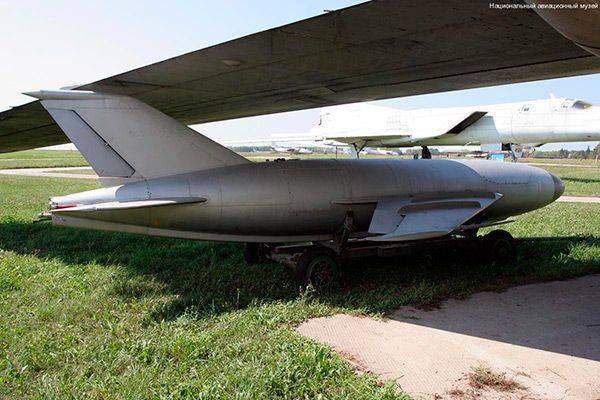
In accordance with the increased dynamic characteristics of the rocket, a new autopilot APK-D was used with more powerful, self-sustaining steering gears.
Cumulative high-explosive warhead weighing 940 kg borrowed from the developed K-10C missile. Provided and a special warhead. To ensure the safety of launches, the rocket was equipped with a course and range limiter — onboard equipment that interrupts the flight with an unacceptable deviation from the given direction and after the maximum estimated duration of the flight to the circuit.
For testing prepared Tu-16. Station KN refined to provide longer guidance. As on the aircraft of the KS, the special operator's pressurized cabin was located in the front bomb bay, without providing any decent conditions - in the summer the operator had to work at a temperature exceeding 400С. For the suspension of heavier missiles instead of the girder holders of the DB-E, new DB-245 were used. The test crew was commanded by the Hero of the Soviet Union V.V. Zentsov.
During the first six tests conducted in June-September 1958 of the year, 96 direct hits were recorded by launching targets at a distance of up to 4 km. This confirmed the 80% probability of hitting the target. When starting on ground targets - small corner reflectors, the impact was recorded by damage to the grid stretched in front of them. The tanker Chkalov, which was dugged in shallow water, was used as a typical cruiser class sea target.

When testing also confirmed the safety of the separation from the underwing pylon of a fairly heavy rocket. And at this moment the carrier received a significant roll with a turn, which required the intervention of the pilot - the autopilot could not cope.
Tests on landing with suspended missiles took place. Before approaching the airfield, the oxidizer merged from the tanks of the rocket - in contact with the main fuel it spontaneously ignited, which in the emergency situation had very serious consequences.
Along with the positive results, tests revealed the impossibility of a significant increase in the launch range in comparison with the CS due to regular failures of the guidance system. All 5 launches that were carried out on targets at a distance of 130-150 km, which were completed in September-October, ended in failure. In addition, the unreliability of the fuel injection system during long-term negative overloads was revealed.
The solution to the problem of ensuring the distance was found outside the originally planned range of work on the DAC theme. In August, the government set the task of 1959 for the industry to create a K-10 rocket based on K-14С to arm Myaschische bombers. The development of on-board equipment was planned to be carried out on a DAC rocket, and according to test results, it was possible to assess the feasibility and feasibility of converting the Tu-16X into carrier aircraft with similar equipment.
As the role of the rocket weapons Myasishchevsky KB was transferred to V.N. Chelomeyu, and the K-14 theme is closed at the beginning of 1960. However, work on the new onboard equipment - the active radar homing head for the air-ship cruise missile continued, as their successful completion promised a significant expansion of the combat capabilities of the complex. For the first time in the Soviet Union, a rocket after launch could act, free from a rocket carrier. Further rapprochement of the carrier with the aim was not required, that is, it was provided for combat use on the "shot and forget" principle.
The new on-board equipment, KS-PM, in combination with the Rubin-1K aircraft radar (replacing the Rubidium TU-16 radar and the K-NM station), has become a Rubicon-1K system. Surface class cruiser target - aircraft radar detected at a distance of about 200 km. The launch of the rocket was carried out at a speed of 700-800 km / h and altitudes from 4000 to 10000 m. Through 7 seconds after separation from the rocket carrier, LRE was activated at maximum thrust. The rocket in 40 seconds reached the speed of 1200-1250 km / after which the engine switched to low thrust, and the DAC-2 (this designation received a new rocket) flew at a constant speed to the target, leading to the current or anticipating target point in two planes. When approaching the target on the 18 km, the GOS antenna was fixed at the pitch angle. In the GOS, the rocket used a larger antenna - the diameter of the radio transparent fairing increased to almost the 2 / 3 mid-section.
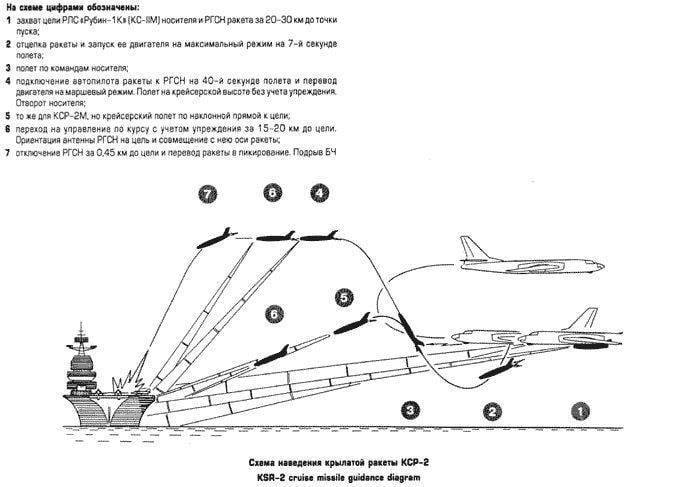
In addition to the new high explosive-cumulative warhead of the FK-2 of lower weight (850 kg) for the missile, a high-explosive fragmentation warhead with an active shell was provided for. In the course of the tests they also verified the possibility of attacking radio-contrast ground targets. An indirect confirmation of the reality of combat use for purposes such as hydropower plants, railway stations and even individual enterprises within the city can serve as successful launches of P-15 missiles on Pakistani coastal objects made by Indians during 1971 combat operations of the year.
Even before the completion of these tests in February 1961, the government adopted a resolution on the conversion of the Tu-16X and Tu-16 to the modification of the Tu-16CR-2 from Rubicon. The act on the results of the joint tests was signed at the end of 1961, and on December 30, the K-16 complex was accepted into service. Over a period of just over a year, more than 70-Tu-16 were re-equipped as carriers of the KCR-2 missiles.
If K-16, in terms of combat use, was a direct development of Kometa, then the K-11 complex that was tested almost simultaneously with it was intended for solving a fundamentally new task - hitting the enemy’s radar station.
The development of the air defense system of the probable enemy, the saturation of its anti-aircraft missile systems prompted the government in July 1957 to give the task to develop a missile system capable of hitting various types of radars, including anti-aircraft missile guidance stations. The work was proposed to conduct in relation to the missiles of the COP or the DAC. For practical implementation, the DAC missile was adopted as the most promising and allowing the installation of a large antenna. In the future version of the missile with a passive radar homing head (PRGSN) assigned the name of the KSR-11. For the new complex, the PRGSN missiles and the target reconnaissance station of the Ritsa aircraft carrier had to be developed.
The test results confirmed that Ritsa provides detection in the search sector +/- 230, surveillance radars at a distance of 350 km, gun guidance stations and 270 km. Broadband impulse PRGSN 2PRG-10, provided the capture radar targets at a distance of 280 km at flight altitude - 10000 m or 190 km from 4000 m. Search capabilities onboard equipment KSR-11 inferior aircraft, therefore, after finding the target from the station " Ritsa "on the GOS received the necessary information to configure. By ensuring the capture of the PRGSN at a greater distance, it was possible to increase the launch range of the DAC-11 to 200 km, which is a third longer than the DSR-2 range. The flight of the rocket was carried out at the height of the launch piece, and then it swooped on the target at an angle of 250.
The rocket was equipped with three different types of warheads (high-explosive, high-explosive fragmentation and high explosive-cumulative). The smaller mass of the onboard equipment made it possible to reduce the weight of the rocket to 4000 kg. The increased launch range and reduced mass of the rocket made it possible to expand the range of the K-11 system to 2050 km.
The act of testing conducted on the Tu-16 was signed in December 1961 of the year - earlier than the corresponding document on K-16, but the complex was adopted only in April 1962 of the year. Thus, it was in our country that the world's first serial anti-radar missile was created.
In the United States, subsonic anti-radar missiles were also tested in the 1950s. For the armament of the carrier-based aviation, a Corvus rocket was developed, and for the Strategic Air Command of the Air Force, the Crossbow was developed, but none of them was completed. Only in 1964, the Shrike, widely and quite successfully used in Vietnam and other local wars, entered service.
The high level of unification of the KSR-2 and KSR-11 products and the relatively small weight and size parameters of the corresponding aircraft equipment made it possible to create a single carrier based on the Tu-16. The new system is called K-11-16. Initially, it was planned to re-equip the Tu-16A bombers, as well as the Tu-16ZA tankers, and later developed the technology for the re-equipment of the Tu-16X missile-carrying ones. The new complex allowed the simultaneous launch of two KSR-2 on one target. After successful tests, the K-11-16 complex began to flow into combat units.
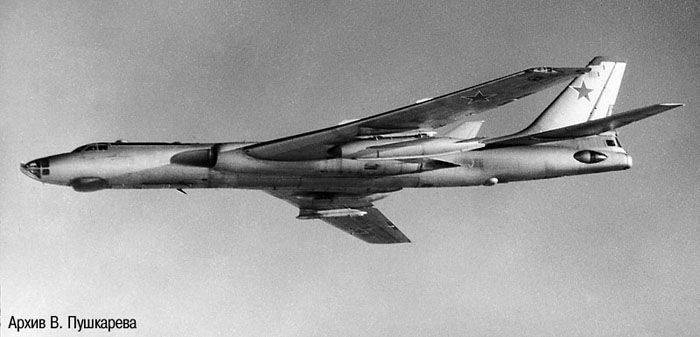
At the end of the fifties, the task was rather acute - testing new anti-aircraft missile and fighter aircraft complexes. Prior to that, unmanned versions of fighters and bombers and a specially designed subsonic target La-17 and its modifications were used as air targets. To test the new systems, a target that was too expensive with flight-technical characteristics close to those of the most advanced aircraft of that time was required.
The leadership of the USSR in July 1959 set the task for the industry to develop new targets and unmanned aircraft. It was prescribed to create a target with autonomous control based on a DAC rocket. It was prescribed to increase the speed to 2500 km / h, and flight altitude to 25000 m. It was envisaged to ensure the growth of characteristics through the use of more powerful VG-RN-209-300 LRE-R-X. Stepanova. The works were completed successfully, and already in 1963, the carriers of the Tu-16 launched the KM targets during the tests of the C-200 SAMs.
The serial production of products KSR-2, KSR-11 and KM was assigned to the plant number 475 in Smolensk. However, the start of mass production of the CSR-2 was delayed due to the disruption of supplies of the KS-NM equipment. Delaying the start of the series contributed to the increasing moral obsolescence of the complexes.
When comparing the characteristics of the K-16 with its peer-to-K-10 complex, it can be seen that in terms of flight speed and launch range, the KSR-2 loses the K-10С rocket on 50-70% on 16 km is inferior to the corresponding indicator Tu-11К-16. The fact that the Tu-400K-16 carried only one rocket, and in terms of the range of approach to the chain both complexes had almost the same indicator - 10-16 km, could not, in the opinion of the military, compensate for the apparent inconsistency between the early sixties of the transient speed of the DAC. Therefore, in order to re-equip the K-10-120 complex, in August the 140 government issued an assignment to the K-11 complex with a KSR-16 rocket equipped with an active radar homing facility. But its development using basic technical solutions designed to arm the Tu-1962 of the K-26 complex with the X-5 rocket was delayed until the 22 year, and the anti-radar version of the KSR-22P rocket, which began on February 22, could come on replacing the DAC-1969 at an even later date.
As well as K-10, the K-11-16 complex was being developed in chains for increasing the range of launches and expanding the range of combat use heights. When launched from high altitudes, the range of the DAC-11 could reach 200 km. However, after the introduction of air defense systems in the air defense missile system, attack aircraft began to fly at low altitudes. Unlike the K-10C, the K-11-16 missiles were separated from the carrier before the engine was turned on, which led to the missile’s "drawdown" from the launch height. Nevertheless, in the mid-sixties, it was possible to ensure the launch of rockets from heights of the order of 500 m.
From the late sixties, photographs of the KSR-2 or KSR-11 missiles under the NATO code "Celt" began to appear on the pages of foreign publications. The not too high level of tactical and technical characteristics of the K-11-16 complex facilitated its delivery to friendly countries. Due to this, the K-11-16 turned out to be the only sample of the “large” ground-to-air missile systems used in real combat situations.
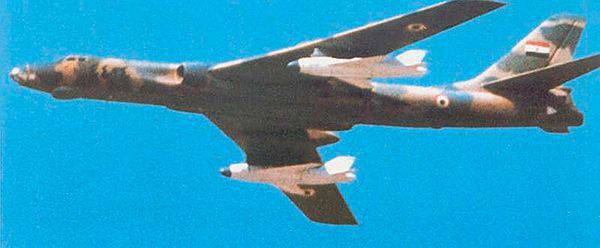
According to data published in the Western press, during the Arab-Israeli "Doomsday War" in October 1973, the Egyptians made 27 rocket launches of this complex. Most of them were allegedly shot down by Israeli fighters, but a pair of missiles reached targets - the radar and field supply base. It should be noted that export CSR-2 worked only on one frequency. However, the main result of the timely creation of rockets - the KSR-2 and KSR-11 was not this battle episode, but the preservation of the Tu-16 grouping during the difficult period of rocket euphoria.
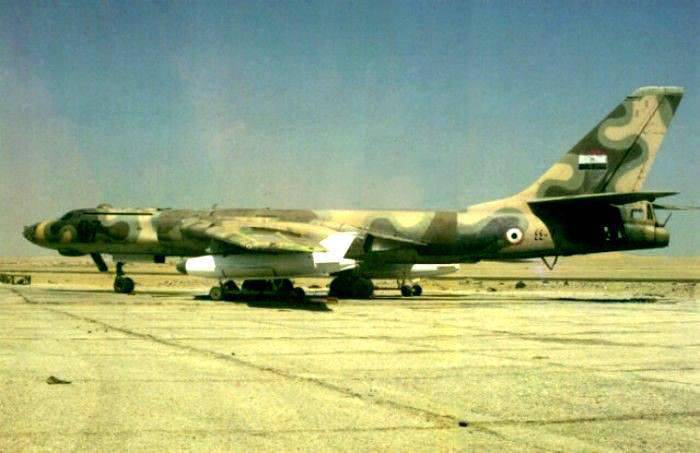
With the introduction of high-performance DAC-5 and DAC-5P, the first air force missiles with liquid engines went over to the "second category" reserve and were planned for combat use when more advanced missiles were used up. It is curious that in this “pre-retirement” state, the KSR-2 and KSR-11, along with missiles of the KSR-5 type, were also used with the modified Tu-16K-10, which received the designation Tu-16-К26. As the warranty period expired, the missiles ceased in production gradually became a thing of the past, but the Tu-16 saved by them remained in service until the early nineties.
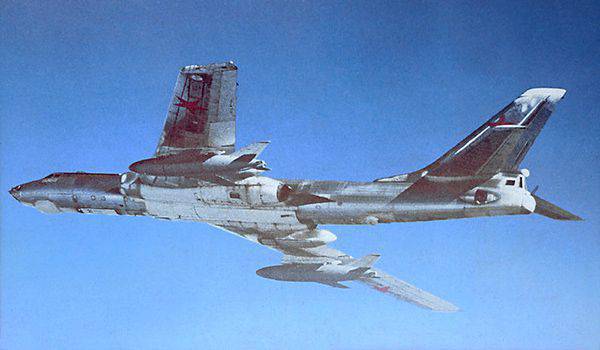
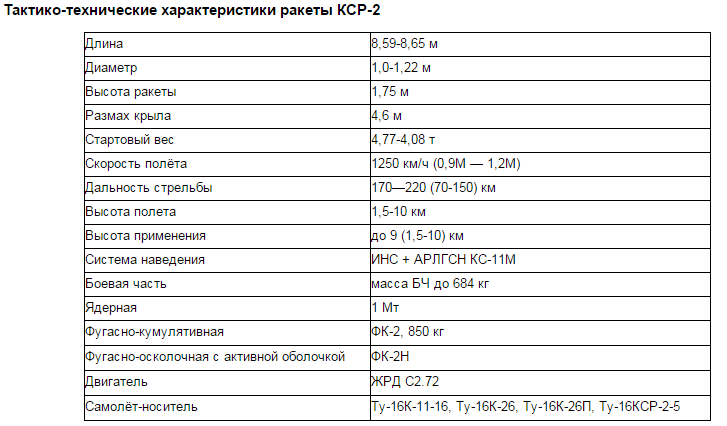
Sources:
Shirokorad A. History aviation weapons. Minsk: Harvest, 1999. C. 310-315.
Artemov A. Wings over the sea // Aviation and cosmonautics. 2008. No.8. C.18-20.
Angelic R. Rocket KSR-2 for Tu-16 // Wings of the Motherland. 1998. No.98. C.13-15.
Moroz S., Popsuevich S. Guided missiles of the USSR long-range and naval aviation. M .: Major, Pilot, 2001. C.35-39.
Gordon E., Rigmant V. Legendary Tu-16 // Aviation and Time. 2001. No.2. C. 5-8.
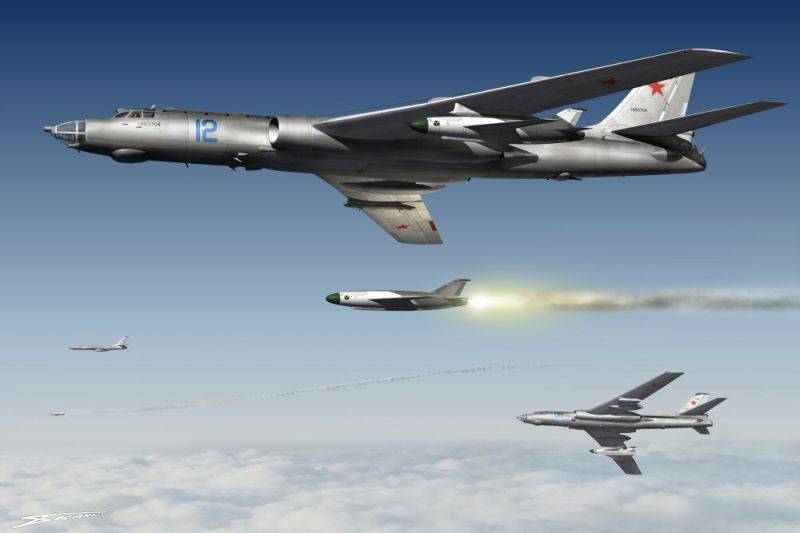
Information